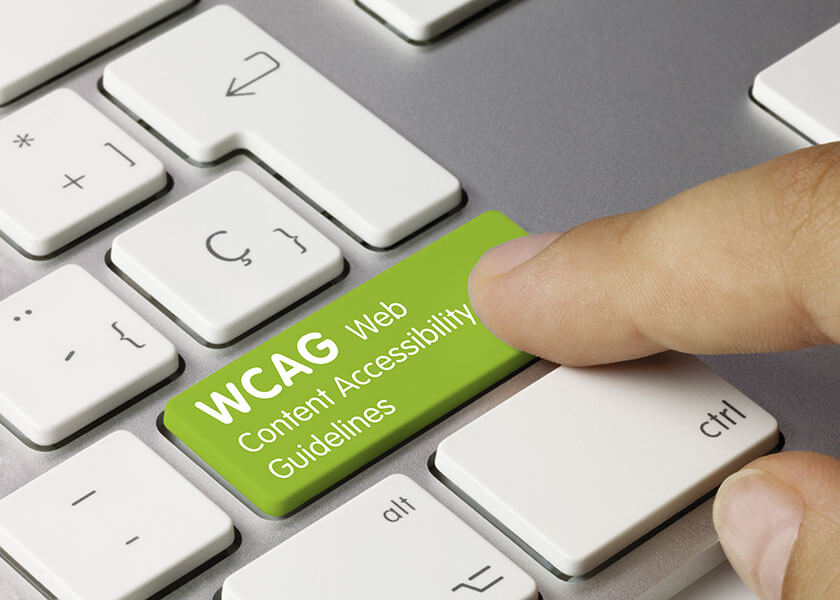Guaranteed Accessibility From a Trusted Agency
With laws in place for accessibility guidelines, complying with regulations such as AODA standards is a necessity. However, ensuring that details such as color differentiation, contrast levels and input forms are fully accessible can be a daunting task. That is where Apiqu comes in. Our team of design, development and content experts is highly experienced in providing quality websites that are completely AODA compliant, freeing you from the headache.

Introduction to Accessible Websites
In simple terms, web accessibility is the design and development of tools and technologies to accommodate people with disabilities. The goal of web accessibility is to allow everyone to understand, interact with and navigate and have the ability to contribute to apps and websites.
Forms of disability that can affect access to the web include visual, speech, visual, neurological, physical, cognitive and auditory.
Web accessibility can also affect those without disabilities. This includes people viewing the web on devices other than a computer (smartphones, tablets, smart TVs), elderly users, temporarily disabled users (broken bones, temporary eye problems etc), situationally limited users (audio not working, brightness affected by environment etc) and those with temporary or permanently limited Internet capacities.

While website accessibility can be quite complicated, it generally falls under the following criteria:
The Need for Accessibility
With 91% of the population using the Internet regularly, web accessibility has become increasingly important. Accessibility provides equal access and equal opportunity for web usage. Accessibility has also become increasingly important for business success as it has a profound effect on user/customer satisfaction.
Since the invention of the world wide web and its inclusion in everyday life, the world has experienced an unprecedented level of access to information. For the majority of North Americans, the Internet has become the primary way source for obtaining information and resources. Unfortunately, web use and access are not always as easy for certain portions of the population, as 90% of websites are inaccessible to people who rely on assistive technology. In a study conducted by Pew Research, 23% of disabled respondents have stated that they never go online. Making your website accessible can assist in empowering those who would not otherwise be able to access your content.


Web accessibility is important, not only for potential customers but for employees. One of your employees may have a disability and need to use your website or app to fulfill their role. Accessibility issues can affect your entire team beyond your web development/design team. Your job postings / online hiring process should also be accessible to potential employees with accessibility issues. Otherwise, you could unintentionally be discriminating against them. This leaves you legally liable and limits you from receiving applications from potential star candidates.
Along with social responsibility, brand perception should always be at top of mind. Today’s consumer cares more than ever about corporate social responsibility. Customers value companies that place inclusivity and customer appreciation at the forefront of their business practices and operations. In contrast, a company that is not socially responsible could experience a damaged reputation. Making your website accessible is can assist in ensuring that your company stays socially responsible and that your brand remains inclusive.


According to the CDC, an estimated 26% of North Americans live with some form of disability. Not making your website accessible isolates a large portion of potential customers, resulting in a decrease in consumer loyalty and overall sales. The more customers that have access to your products or services, the more business you will have. Another element to consider is that a large number of your customers who do not currently disabled may have either a temporary or permanent disability of some form in the future. Keeping your website accessible will ensure that those customers remain customers in the future.
Careful consideration should be given, not just to your overall web content, but to the ordering and checkout process. Making the entire sales cycle accessible to everyone will ensure that your web traffic proportionally translates into sales.


Having an accessible website is often a requirement by law, and can also leave you open to potential lawsuits. Ensuring accessibility compliance can save you from any liability and future lawsuits.
Search engines value inclusivity. Placing importance on accessible web practices not only ensures inclusivity, but can also profoundly affect your SEO.

AODA Compliance
One in five Canadians has a disability of some kind. Fortunately, regulations such as the Accessible Canada Act and The Accessibility for Ontarians with Disabilities Act (AODA) have established accessibility standards that allow this portion of the population to access information more easily.
Website Accessibility From All Angles
Apiqu is experienced in providing in depth analysis of web accessibility as measured against all guidelines and AODA Website Compliance standards.

Any in-house developer or web development agency should know how to incorporate accessibility into your development.
Is your developer familiar with WCAG 2.0, Level A and AA?
Does your developer code manually or do they use a coding software? If they use a coding software, does it support accessibility?
Does your developer have links or references to websites they have worked on that follow accessibility standards?
How does your developer test websites? Is it through automated or manual assessment?
A professional developer should provide you with a project plan that will detail your development and the incorporation of web accessibility.
What accessible coding techniques will your developer use? If software is being incorporated, does it support accessibility?
How will the website be maintained? If an agreement for ongoing maintenance is not in place, your developer should train your staff on creating accessible content and maintaining accessibility during site updates.
What will the website testing process look like? This portion of the plan should include both manual and automated tests. Specific assistive testing technology such as screen Website Maintenance readers should be used.
You should know exactly when and how your project will be delivered.

Trust The Experts
Apiqu has seen it all. Our web accessibility team’s breadth of experience allows us to find and resolve any design and usability barriers at unprecedented speeds, saving you time and money:
World Class Accessibility Support
Apiqu’s website Accessibility team offers accessibility audits, certifications, accessible design and accessible website development to assist organizations in achieving accessibility guidelines and best practices:
Trust the experts